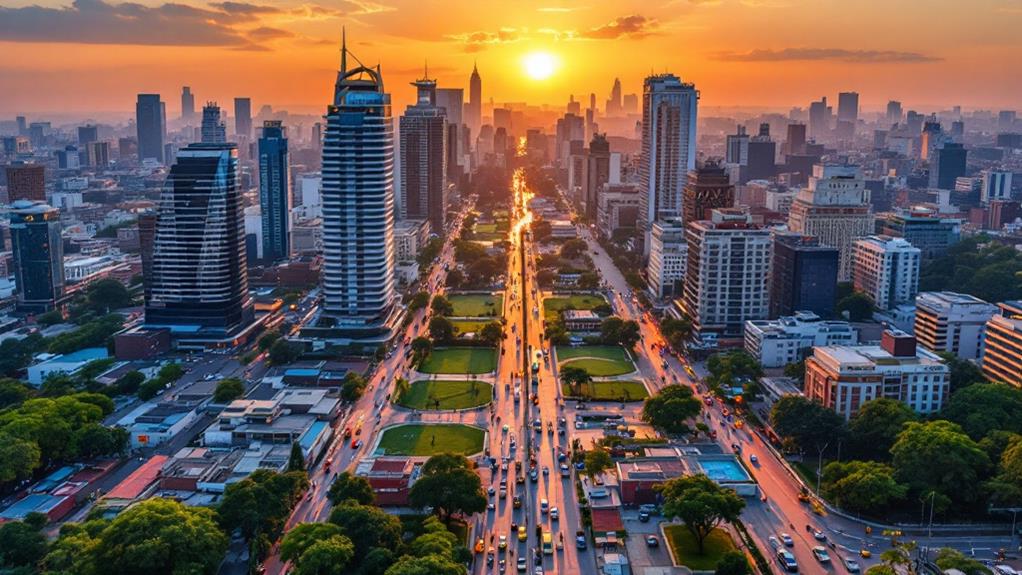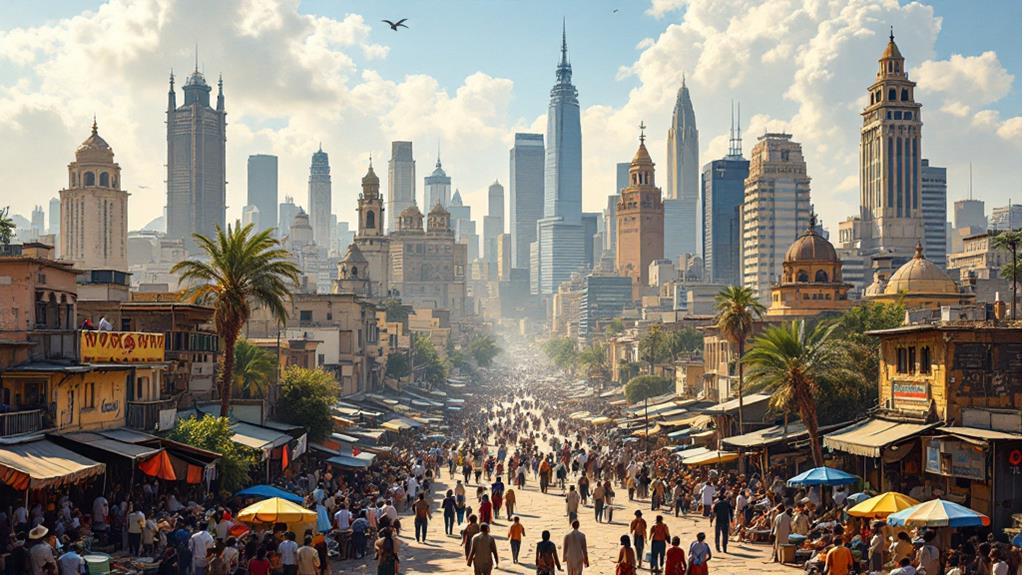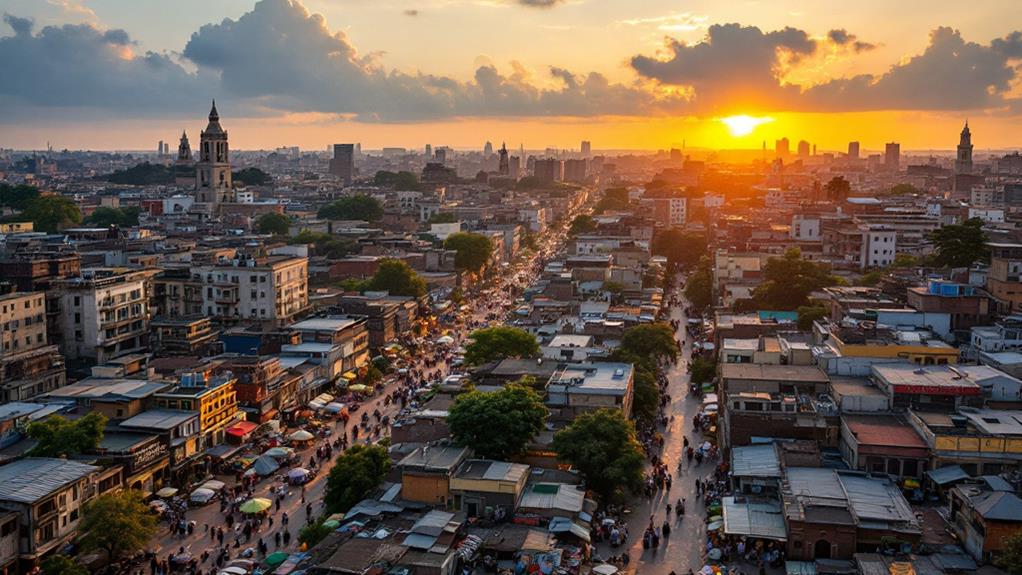The Largest Cities in Africa: Cultural and Economic Powerhouses

Africa's largest cities such as Lagos, Cairo, Johannesburg, and Kinshasa are dynamic hubs of cultural and economic significance. Lagos alone contributes a whopping 25% to Nigeria's GDP and is expanding with projects like the Light Rail. Cairo, home to 22 million people, stands as an essential trade hub with its iconic Pyramids. Johannesburg boasts the continent's oldest stock exchange, while Kinshasa thrives on its rich music scene and mineral exports. These cities face urban challenges, from congestion to infrastructure strain, but innovations promise transformative growth. If you're curious about how these metropolises tackle their unique challenges, there's much more to uncover.
Cities as Economic Engines
As you investigate Africa's lively urban landscapes, it's clear that cities like Lagos, Cairo, Johannesburg, Kinshasa, and Casablanca are more than just population hubs; they're the continent's economic engines driving growth and development. Lagos stands out as an economic powerhouse, contributing about 25% of Nigeria's GDP. With its rapid urbanization, it's projected to house 25 million people by 2035, underscoring its role as a key financial hub.
Cairo, with its thriving population of over 22 million, excels as a center of trade and commerce in the MENA region. Its diverse economy spans tourism, manufacturing, and trade, making it indispensable to Egypt's economic success. Meanwhile, Johannesburg, often dubbed Africa's financial capital, hosts the Johannesburg Stock Exchange and numerous corporate headquarters, cementing its status as a critical economic engine.
In Kinshasa, the mining and mineral industries flourish, exporting valuable resources like copper and cobalt, contributing greatly to its rapid urbanization and economic growth. Finally, Casablanca serves as Morocco's economic capital, with its robust finance, trade, and manufacturing sectors driving North Africa's economic expansion. Together, these cities epitomize the dynamism of Africa's urban landscapes.
Cultural Vibrancy and Heritage
While these lively cities drive Africa's economic growth, they also pulsate with cultural dynamism and rich heritage that define their unique identities. Lagos, Nigeria, stands out with its lively music scene, especially Afrobeat, and traditional Yoruba festivals, offering you a taste of its diverse culinary landscape and rich cultural heritage. Cairo, Egypt, enthralls with its historical significance, featuring iconic monuments like the Pyramids and the Egyptian Museum, which highlight the city's depth and attract countless tourists.
In Kinshasa, the Democratic Republic of Congo, you'll find a cultural hub that thrives on artistic expression, particularly through the soukous music genre, embodying the city's spirited nature. Johannesburg, South Africa, offers a dynamic urban life, blending a rich history in mining with a melting pot of languages and traditions, showcasing its diverse cultural landscape. Casablanca, Morocco, seamlessly merges traditional markets with modern influences, creating a lively arts scene and culinary diversity, reflecting its status as a major cultural and economic hub.
Explore these enthralling aspects:
- Afrobeat music and Yoruba festivals in Lagos
- Cairo's ancient monuments and cultural depth
- Kinshasa's energetic soukous music scene
- Johannesburg's linguistic and traditional diversity
- Casablanca's blend of traditional and modern influences
Population Dynamics

Urban centers like Cairo, Lagos, and Kinshasa are experiencing explosive population growth, reshaping the demographic landscape of Africa. This rapid growth signifies a monumental shift in population dynamics across the continent. In Cairo, with its 22.6 million residents, urbanization fuels its role as a crucial economic hub in the MENA region. Lagos isn't far behind, boasting a staggering 21 million people, contributing to its status as Nigeria's financial powerhouse, generating a significant portion of the nation's GDP.
Kinshasa's population has swelled to approximately 17.2 million, reflecting substantial migration inflows that bolster the city's informal economy. Meanwhile, Johannesburg, with its 6.3 million inhabitants, remains a central economic hub, known for its diverse industries, including finance and mining. The rapid growth in these cities highlights the pressing challenges of urbanization.
Population dynamics in these metropolises are heavily influenced by migration, as people flock to cities in search of better opportunities. This influx strains existing infrastructure, demanding creative solutions to accommodate the burgeoning populations. As you investigate these cities, you'll witness firsthand the dynamic interplay between growth, migration, and urbanization, shaping Africa's future.
Key Infrastructure Developments
The rapid population growth in Africa's largest cities demands immediate attention to infrastructure. To foster economic growth and improve urban mobility, these cities are undertaking significant infrastructure developments. In Lagos, the Lagos Light Rail and Bus Rapid Transit (BRT) systems aim to alleviate traffic congestion and boost public transportation efficiency. Cairo is modernizing its transportation networks by expanding the Cairo Metro, which increases connectivity and reduces urban congestion.
Johannesburg has introduced the Gautrain, a rapid rail system that connects key areas, thereby promoting sustainable urban mobility and cutting travel times. Kinshasa is focusing on urban policies that improve logistics and transportation infrastructure, addressing challenges from rapid urbanization. Meanwhile, Abidjan is upgrading road networks and public transportation systems, facilitating economic growth and better urban living conditions.
Here are some of the key infrastructure developments transforming Africa's largest cities:
- Lagos Light Rail and BRT systems
- Cairo Metro expansion
- Johannesburg's Gautrain
- Kinshasa's transportation-focused urban policies
- Abidjan's road network improvements
These infrastructure advancements highlight each city's role in tackling urban challenges and preparing for future growth. As you observe these developments, consider how they contribute to the cities' overall economic and cultural dynamism.
Urban Challenges and Solutions

How do Africa's largest cities navigate the intricate maze of urban challenges they face? Rapid urbanization is at the forefront, with cities like Lagos projected to swell to 25 million by 2035. This surge strains infrastructure, leading to housing shortages and traffic congestion. In Cairo, over 9 million residents grapple with significant urban challenges such as pollution and traffic, which deteriorate the quality of life.
Johannesburg confronts economic inequality and high crime rates, formidable obstacles in becoming a true economic powerhouse. These urban challenges require strategic urban planning and investments to promote sustainable development. Kinshasa, with its burgeoning population of around 14 million, faces inadequate infrastructure and widespread informal settlements. Addressing these issues is vital for the city's sustainable growth.
You'll also find cities like Nairobi and Dar es Salaam experiencing similar predicaments. Rapid urbanization and informal settlements demand improved infrastructure and urban planning to elevate living conditions. Solutions involve integrating sustainable urban planning with investments in infrastructure to bridge economic inequality and improve the quality of life. Tackling these urban challenges head-on is fundamental for Africa's largest cities to thrive and continue their cultural and economic contributions.
Future Prospects and Innovations
Africa's largest cities are not just grappling with urban challenges, they're also at the forefront of pioneering solutions for future growth. In Lagos and Nairobi, smart city initiatives are transforming urban landscapes by integrating technology to improve public services. As a city resident, you can expect to see significant changes, such as the Lagos Light Rail, which is part of broader transportation projects aimed at reducing traffic woes and enhancing mobility.
Here's what you can look forward to:
- Smart city initiatives: These efforts will revolutionize how cities are managed and services delivered.
- Transportation projects: From the Lagos Light Rail to Bus Rapid Transit systems, these will ease congestion.
- Economic diversification: Tech startups in Johannesburg and Cairo signal a shift from traditional industries.
- Infrastructure investments: These are essential for accommodating rapid population growth and improving living standards.
- Opportunities in entrepreneurship: Digital platforms are opening new markets for small businesses.
Urban policies are becoming more proactive, with cities investing in infrastructure to meet the demands of fast-growing populations. The tech sector is a key player in this transformation, fueling economic growth and innovation across the continent. Welcome these changes as cities evolve into thriving economic and cultural hubs.



